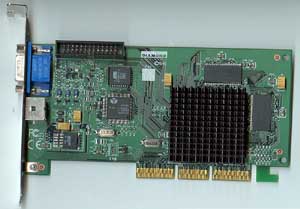S3 Savage 2000 (Diamond Viper II)
by Anand Lal Shimpi on November 18, 1999 10:46 PM EST- Posted in
- GPUs
On Paper
Since the initial 700 megatexels/s number was released, it has since been amended by S3 to read "up to 700 megatexels/s" with the actual product falling in at 500 megatexels/s, just slightly above the performance of the GeForce 256, on paper. The Savage 2000 architecture is quite flexible in terms of what it can do with that fill rate. The actual clock speed of the core is 125MHz, meaning that the 500 megatexels/s number is obtained by quadrupling that clock speed, meaning that the chip itself is capable of processing four texels per pass. The QuadTexture Engine allows the Savage 2000 to apply four textures to a single pixel, as the name implies, or two textures to two pixels.
This is in contrast to the GeForce 256 which is capable of processing four single textured pixels or two double textured pixels per pass. The only advantage the Savage 2000 has here is that it can do a single pass quad textured pixel, whereas the GeForce 256 can only do a single pass on a dual textured pixel.
While, on paper, this may make a difference, it shouldn’t make any difference in real world gaming. The reason behind this is that although a Savage 2000 can do a single quad textured pixel in one pass, the GeForce 256 can do two dual textured pixels in one pass and thus with another pass it can apply four textures to those two pixels. This means that in two passes, the Savage 2000 can do two quad textured pixels and so can the GeForce 256. In essence, the QuadTexture engine is nothing special and mostly a marketing term.
The disadvantage, however, comes in single texture games where the Savage 2000 cannot process four single textured pixels per clock, while the GeForce and other cards can. This isn't such a big deal any more because the days of the single textured game are numbered. In fact, most games that are simple enough that performance will generally not be an issue on a card like this.
The Savage 2000 offers, like its competitors, a 128-bit memory bus that operated at 155MHz. The 155MHz frequency is sort of an odd choice, because 7ns memory guarantees 143MHz operation and 6ns memory guarantees 166MHz operation, making 155MHz somewhat high for qualification with 7ns chips and below the 166MHz rating of 6ns chips. The only reasonable explanation for this frequency rating is that S3 anticipated that board manufacturers (specifically Diamond, since very few others have actually talked about Savage 2000 products) would be using 6.5ns/153MHz memory. In any case, the 155MHz memory frequency is noticeably lower than the 166MHz rated frequency of the memory on GeForce boards, putting the available bandwidth at 2.5GB/s on the Savage 2000 versus the 2.65GB/s on the GeForce. The thing to keep in mind is that, in spite of this limitation, the board will most likely ship with at least 6ns memory and will thus allow you to overclock to 166MHz and beyond since memory chips are rated quite leniently.
As we mentioned earlier, the Savage 2000 features an on-board hardware transform and lighting engine known as S3TL. The engine is supposed to be simpler than that found in NVIDIA’s GeForce, but S3 has been claiming that it is just as capable. In spite of this, the Savage 2000 features about half of the amount of transistors of the GeForce (12 million vs 23 million) and with almost identical chips, it leads one to wonder why S3TL can supposedly do just as much as the GeForce’s T&L without the chip being nearly as complex as the GeForce.
The Savage 2000 still offers support for S3TC, the texture compression algorithm S3 has been using since the introduction of their Savage 3D. Support for S3TC has definitely increased but it is still far away from full acceptance. At the time of publication, S3 had a Quake 3 level that took advantage of S3TC; however, due to the fact that the full game has not been released yet, they were unable to show it off. Upon the release of Quake 3 Arena, expect to see this impressive level. Some games are offering S3TC support, like Q3A, not to offer different textures but faster performance using the higher resolution textures.











0 Comments
View All Comments